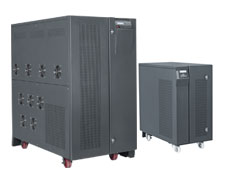UPS System:
I've been looking at a Tesla vehicle today. The Model S is a
magnificent piece of design. At its heart is a modern and rich mix of gadgets,
an electric engine, and a fuel source: a lithium-particle battery pack.
Completely release the battery and the total of what you have is a vehicle that
won't begin. Plug the vehicle into a fast-charging station and inside two hours
you can have a vehicle battery re-energized to 80% of its complete limit.
Any electric vehicle is a mix of two separate frameworks.
Without a battery, the vehicle is 'done for'. This is a lot of something very
similar for a data center UPS framework. In an uninterruptible power supply, we
have a comparative design with hardware and an associated fuel source. In the
Tesla, the batteries as the photograph shows are inside the casing. In a UPS
framework, the batteries might be inside the UPS bureau or a different battery
bureau, or on an open or shut stand.
For UPS frameworks the fuel source is a Valve Regulated Lead
Acid battery. The battery might have a five-year or long-term plan life. Other,
greener energy stockpiling sources are accessible yet these will more often
than not need a higher capital venture. Elective fuel or DC power sources
incorporate lithium-particle batteries, DC flywheels, hydrogen-controlled
energy units, and compacted air-driven DC generators.
The principal contrast between an electric vehicle and a
datacenter UPS framework is that the uninterruptible power supply will possibly
draw on its battery when the mains power supply comes up short or becomes
unsteady. Rather than nonstop use, we have irregular use as a crisis DC fuel
supply to drive the UPS inverter. The subsequent contrast is in the battery of
the executive's framework. Any gadget that utilizes a Lithium-particle battery
must have a more intricate and complex battery charging and the board
framework. Inside such a framework, there are undeniably more sensors and
security elements to screen for and forestall warm out of control.
While most uninterruptible power supply producers will
utilize a wide range of showcasing language to say something else, their
battery the board framework is less modern. However, more than 90% of data
center UPS framework crashes are because of battery issues and fundamental the
battery voltage falling when the abrupt burden is put on it.
In the UPS business, the right depiction for a UPS battery
is the 'UPS battery set'. This is because the set is made up of individual
battery blocks. If you have a petroleum or diesel vehicle, the starter battery
is a battery block. To work with a UPS we size the battery set to have a
specific Ampere-hour (Ah) rating and DC voltage. The DC voltage must be inside
the DC voltage input window of the inverter, for the UPS inverter to have the
option to produce an AC voltage waveform to drive the heap. The Ah-rating
characterizes the runtime accessible at a particular burden as far as power.
Assume we have a DC voltage and Ampere-hour rating. The UPS battery set might
have one battery string or a few strings associated in equal.
All batteries age with use. Their real-life expectancy is
directed by various variables including surrounding temperature and regularly
200-300 charge/release cycles. As batteries age, impedance increments. This is
a protection from the progression of electrons between the battery plates and
prompts hotness to develop. At last, the obstruction is high to such an extent
that the battery can't hold an adequate charge. Batteries will likewise
progress in years at somewhat various rates, as they are compound response
frameworks.
Most UPS frameworks will consequently test their batteries
at regular intervals and issue an alert code assuming a limit or DC voltage
boundary falls under a pre-set level. The issue for datacenter administrators
is that this testing is for the generally associated battery set. The firmware
and gadgets with a UPS framework are for the most part unequipped for
recognizing a debilitating battery block inside the general battery set.
Whenever there is a development of bombing batteries, the main sign for the
datacenter administrator might be a UPS caution or the disappointment of the
UPS framework to help the heap during a power cut.
One thing that datacenter directors frequently report is
that the runtime accessible from their UPS frameworks when mains power is
available will in general diminish rapidly during an initial couple of moments
of a power cut and afterward balance out. This is because of the UPS firmware
assessing the runtime and battery charge % and the abrupt effect of drawing
power from the VRLA battery set. With a Lithium-particle battery, the more
complex battery charging and checking framework is more exact; as it should be
if EV drivers are to have the option to precisely depending on their fuel
measure.
What can likewise occur with a UPS battery is an unexpected
breakdown of the DC voltage. This is the regular of a battery set that is past
its functioning life. In this situation, a UPS framework crash is inescapable
if the mains power supply has not been reestablished or a reserve power
generator began. The static switch, which gives a UPS framework its innate
unwavering quality, has no optional inventory to move the basic to like the
resulting voltage from the UPS inverter breakdowns.
So what can datacenter administrators do to forestall this
direst outcome imaginable? There are two arrangements. Such frameworks may just
be practical monetarily for extremely huge uninterruptible power supply
establishments. The framework depends on individual battery sensors being
associated with every battery block and associated with a battery checking
station or CPU. Every battery block has an interesting ID and information recorded locally or on the
Cloud for pattern investigation. As the observing is constant caution
conditions are accounted for right away.


No comments:
Post a Comment